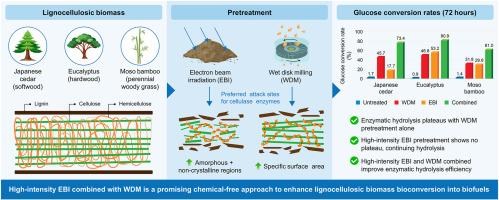High-intensity electron beam irradiation coupled with wet disk milling for enhanced enzymatic hydrolysis of lignocellulosic biomass
IF 2.8
3区 物理与天体物理
Q3 CHEMISTRY, PHYSICAL
引用次数: 0
Abstract
The aim of this study was to evaluate the effectiveness of combining high-intensity electron beam irradiation (EBI) with wet disk milling (WDM) as a chemical-free pretreatment in enhancing the bioconversion efficiency of lignocellulosic biomass. This combined approach rapidly reduced cellulose recalcitrance without generating chemical waste, making it environmentally friendly and potentially scalable for industrial applications. Three types of lignocellulosic biomass, namely Japanese cedar, Eucalyptus, and Moso bamboo, were pretreated with high-intensity EBI, WDM, or a combination of both methods. Pretreatment effects were evaluated by analyzing the enzymatic hydrolysis efficiency of cellulose to glucose, crystallinity index (CrI), chemical composition of the biomass, specific surface area (SSA), and morphological observations using a scanning electron microscope. The effect of high-intensity EBI on CrI and chemical composition varied by species. Eucalyptus, a hardwood species, demonstrated a substantial improvement in enzymatic hydrolysis efficiency with high-intensity EBI pretreatment alone, suggesting a high susceptibility to this treatment. SSA measurements and morphological observations demonstrated that high-intensity EBI pretreatment enhanced the fibrillation efficiency of subsequent WDM pretreatment across all species. Although individual high-intensity EBI or WDM pretreatments yielded a limited glucose conversion, pretreatment with high-intensity EBI followed by WDM improved the glucose conversion rates by 43.2 %, 90.0 %, and 43.6 % for Japanese cedar, Eucalyptus, and Moso bamboo, respectively, compared with the untreated control. These results demonstrate the synergistic effect of the combined pretreatment (high-intensity EBI and WDM), markedly enhancing the enzymatic hydrolysis efficiency across diverse lignocellulosic feedstocks. The combined pretreatment is a potentially effective, environmentally friendly strategy for large-scale biorefineries.

高强度电子束辐照与湿圆盘铣削相结合,增强木质纤维素生物质的酶解
本研究的目的是评估高强度电子束辐照(EBI)与湿盘磨(WDM)相结合的无化学预处理在提高木质纤维素生物质生物转化效率方面的有效性。这种结合的方法在不产生化学废物的情况下迅速降低了纤维素的顽固性,使其对环境友好,并有可能扩展到工业应用中。三种类型的木质纤维素生物质,即日本雪松、桉树和毛竹,用高强度EBI、WDM或两种方法的组合进行预处理。通过分析纤维素对葡萄糖的酶解效率、结晶度指数(CrI)、生物量的化学组成、比表面积(SSA)和扫描电镜形态学观察来评价预处理效果。高强度EBI对植物CrI和化学成分的影响因种而异。桉树是一种硬木树种,仅用高强度EBI预处理就能显著提高其酶解效率,表明其对EBI处理具有较高的敏感性。SSA测量和形态学观察表明,高强度EBI预处理增强了所有物种后续WDM预处理的纤颤效率。虽然单独的高强度EBI或WDM预处理产生有限的葡萄糖转化率,但与未经处理的对照相比,高强度EBI预处理和WDM预处理分别使杉木、桉树和毛竹的葡萄糖转化率提高了43.2%、90.0%和43.6%。这些结果证明了联合预处理(高强度EBI和WDM)的协同效应,显著提高了不同木质纤维素原料的酶解效率。联合预处理对于大型生物精炼厂来说是一种潜在的有效的、环保的策略。
本文章由计算机程序翻译,如有差异,请以英文原文为准。
求助全文
约1分钟内获得全文
求助全文
来源期刊

Radiation Physics and Chemistry
化学-核科学技术
CiteScore
5.60
自引率
17.20%
发文量
574
审稿时长
12 weeks
期刊介绍:
Radiation Physics and Chemistry is a multidisciplinary journal that provides a medium for publication of substantial and original papers, reviews, and short communications which focus on research and developments involving ionizing radiation in radiation physics, radiation chemistry and radiation processing.
The journal aims to publish papers with significance to an international audience, containing substantial novelty and scientific impact. The Editors reserve the rights to reject, with or without external review, papers that do not meet these criteria. This could include papers that are very similar to previous publications, only with changed target substrates, employed materials, analyzed sites and experimental methods, report results without presenting new insights and/or hypothesis testing, or do not focus on the radiation effects.
 求助内容:
求助内容: 应助结果提醒方式:
应助结果提醒方式:


